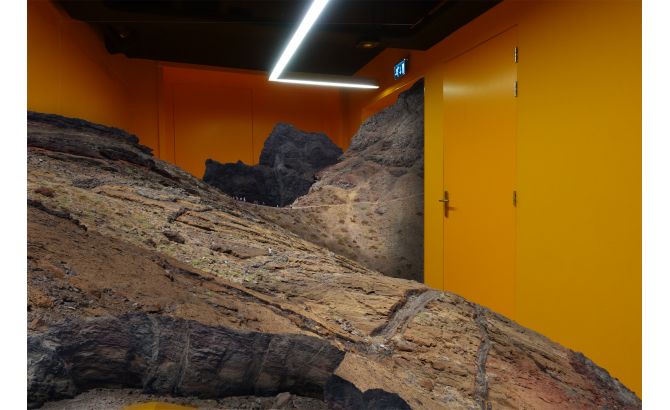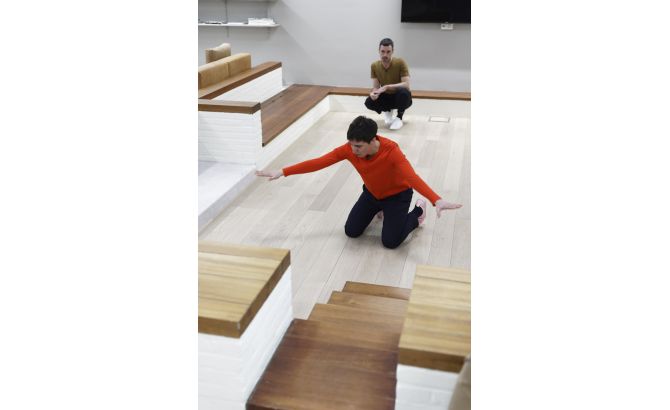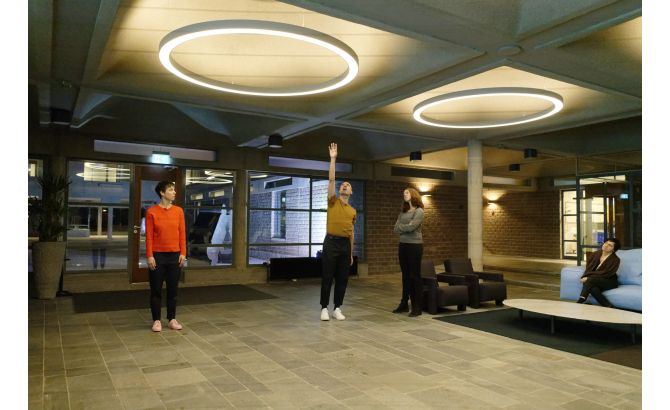Performance by Andrea Božić and Julia Willms | TILT
PoroCity is a performance as a journey based on mapping dreams into architectural locations. The familiar but elusive logic of dreams merges with everyday reality and, in their overlap, a third space emerges – a porous space we do not know yet. A space where anything is possible.
PoroCity weaves the dreams collected from various people into a larger dream narrative. Two performers alias ‘dreamers’ lead the audience through a labyrinth of spaces and map the dreams as though they take place in the here and now. PoroCity moves through a series of special architectural buildings as a living organism, in Amsterdam and further, such as Burgerweeshuis designed by Aldo van Eyck, Frascati Theatre, Huize Frankendael, ROC TOP school and other iconic locations. Each location is a unique experience where the dreams, the location, the building, the audience and the space itself are woven into each other and become part of the performance. The whole series becomes a performance in itself: a unique journey through the city.
As part of PoroCity, we have made a special version of the audio-visual installation Through the Looking Glasses, a no-space experience based on the Ganzfeld effect which can be experienced as part of the performance.
'As a spectator and a 'walker’ you experience a strange mix of personal memories, your own social and historical references and associations, combined with the wonderful logic of dreams that have their own architecture.' ★★★★ Theaterkrant
Premiere: 24 March 2018, 18.30 and 21.00 hrs, Burgerweeshuis (Orphanage) designed by Aldo van Eyck in collaboration with BPD and Frascati in Amsterdam with a tour along a series of special locations in Amsterdam, Netherlands and internationally.
Performance dates PoroCity:
21 & 23 May try out, 24 May premiere, 25 May 2018 performances (18.30 and 21.00), Burgerweeshuis / BPD, Amsterdam
2-3 May 2018 Frascati Theatre, Amsterdam (18:30 & 21:30)
22-24 June 2018 Burgerweeshuis as part of the opening weekend of the GET LOST Art Route and Public Art Amsterdam supported by the BPD, Amsterdam
20-22 July 2018 Over het IJ festival, Amsterdam
8-9 October 2018, Huize Frankendael, Amsterdam
3 November 2018, Huize Frankendael, Museumnacht, Amsterdam
15-16 February 2019 La Casa Encendida, Madrid
23 February 2019 Theater Ins Blau, Leiden
May 2019, SPRING Festival, Utrecht
Further dates and info: Calendar and FB TILT
LOCATIONS:
BURGERWEESHUIS BY ALDO VAN EYCK | BPD
21, 23-25 March 2018 (premiere) in collaboration with the BPD and 22-24 June 2018 as part of the opening weekend of the GET LOST Art Route and Public Art Amsterdam supported by the BPD, Amsterdam
The Burgerweeshuis (Orphanage) (1960) was designed by one of the most famous 20th century Dutch architects Aldo van Eyck to provide accommodation for 125 orphans. The building looks like a casbah or a labyrinth, composed of innumerable interior and exterior spaces interconnected in a complex order and merging into one another almost imperceptibly. In Van Eyck’s vision, the private and the collective were closely linked and the boundary between the building and the city had to be broken down. The Burgerweeshui has just undergone a major restoration and transformation and will soon be open to the public.
BPDis one of the largest European area developers and has been investing in art and culture for decades. BPD has made the Burgerweeshuis available to PoroCity.
FRASCATI
2-3 May 2018
A special version moving through the whole building of the Frascati with an extended programme on 2 and 3 May 2018.
The building is layered with histories of trade, theatre and parties: a Chamber of Rhetoric in the late 16th century held their literary discussions in the cellar of an abbey church experimenting with poetic form and structure. For a while, it was also a house where lepers were kept away from the healthy. In the 17th and 18th centuries, an auction house for tobacco, tea, spices and meat. Later, an Italian coffee house that grew into a huge party centre from 1824, the Frascati Salon, hosting French vaudeville, English variété and Dutch comedies for 50 years and slowly becoming a brothel for less respectable audiences by the end of the century. Sold and rebuilt with balconies and loges as an auction house for real estate and tobacco in the early 20th century, as Amsterdam was the world centre of tobacco trade – the so called hell of Frascati. From the 1970-ies, a theatre space hosting companies working in less hierarchical and more collective structures with socially engaged topics and experimental contemporary works. Today Frascati is an innovative, dynamic theatre with four theatre spaces on the Nes presenting some 700 Dutch and international productions a year and producing some thirty large and smaller-scale productions itself.
ROC TOP NDSM at the OVER HET IJ FESTIVAL
20-22 July 2018
ROC TOP NDSM is a school that offers higher vocational education in trade and entrepreneurships and health care. The school was built in 2016 and the building is fully transparent. It is built in the area that used to be the NDSM yard - the Dutch Shipbuilding Society, which moved there a hundred years ago. It was one of the largest and most modern shipbuilding yards in the world from the 1920s to 1980s regularly launching huge impressive tankers from its slipways. The NDSM closed in the 80-ies due to the oil crisis and political games and transformed in the 1990s into a creative hotspot for festivals, artists studios and creative events – one of them is Over het Ij Festival which is hosting PoroCity. PoroCity moves through the school building – its hallways, classrooms, offices also into the hybrid and rapidly changing spaces outside: the constructions sites the school is surrounded by, the new yacht haven and the emerging apartment buildings which will take over the area by 2025.
8-9 October 2018 and 3 November 2018 (Museum Night)
is the last remaining 17th century estate of Amsterdam. It is located in the Amsterdam East area of Watergraafsmeer that used to be a lake which was dried out in 1629 to make a polder. In the late 17th and early 18th century, some 80 estate houses were built in the polder as it became a popular summer resort for the rich families from Amsterdam during the Dutch Golden Age. The summer resorts became permanent residencies but over the centuries, the city expanded forcing the estates to make space for the advancing city and the investors by fin-de-siècle. Most of the houses were brought down, as the materials were worth more than the houses. Only Huize Frankendael remained. The house has a rich cultural and green history. Used by the nobles in summer time to enjoy nature, art and friendship, inhabited by art lovers and collectors such as the Gildemeester family who owned a large collection of the 17th century masters. During the 20th century, the estate was a horticultural school, a city plantation and an open air theatre, among its other uses. The Frankendael Foundation now presents a contemporary art programme in the building that creates an interesting fusion with this historical national monument. The estate houses are part of the Cannon of the Netherlands.
PoroCity is back at the Huize Frankendael for the Museumnacht Amsterdam 2018 with a special programme in collaboration with Suzanne Sanders and the Frankendael Foundation.
Programme Museum Night at Huize Frankendael 3 November:
20.00 & 20.30 Curator's tour (guided tour)
Julia Mullié, curator of the exhibition The Image of a Private Collection, will give two guided tours of the exhibition in collaboration with the Young Collectors Circle.
21.30 & 22.30 & 23.30 & 00.30 PoroCity (performance)
Andrea Božić and Julia Willms | TILT take the visitors on a PoroCity journey: they weave the dreams collected from various people into the building of Huize Frankendael merging the dreams, the building, its gardens, the audience, the present and the past, other artworks and accidental passers by, fiction and parallel realities into the performance. With Matthew G Day and Julia Willms (performance), Robert Pravda (sound installation), Paul Beumer (light installation)
20.00-02.00 Through the Looking Glasses (audio-visual installation, ongoing)
Enter the light and sound installation based on Ganzfeld effect by Andrea Božić, Julia Willms and Robert Pravda | TILT and subdue yourself to a no-space experience. The eyes see no visible borders of the space, the ears hear no recognisable sound of the environment – the body enters a no-space. A similar training is undergone by astronauts preparing for travel in outer space.
20.00 - 02.00 Billy Mullaney: Welcome, I Have Been Expecting You (performance)
Evoking Frankendael’s historic garden hermit, tonight’s Garden hermit, Billy Mullaney, will be conducting one-on-one oracular performances in a secret location on the grounds of Huize Frankendael. You will be guided there by a stranger when it is your turn. Garden hermits were hermits encouraged to live in purpose-built hermitages or rockeries on the estates of wealthy land-owners during the 18th century. Encouraged to dress like druids and remain permanently on site where they oculd be fed, cared-for and consulted for advice or viewed for entertainment.
22.00-1.00 DJ Gleemaiden (Áron Birtalan)
Bitter-sweet dance tunes & 80's synth by Gleemaiden in the Koetshuis. Gleemaiden is Áron Birtalan: an artist, musician and part-time druid based in Amsterdam. Drowned in walls of reverb, shrouded in veils of echo, Gleemaiden's sets are harbingers of bittersweet dance tunes. Lush weeps, spellbinding rhythms and other curious sounds from an antique future. Oh, and cheap claps.
All night: vegetarian goodies by Huize Frankendael, restaurant Merkelbach - Pearl barley risotto with pumpkin and black kale chips.
All night: Huize Frankendael - the building and its gardens: the last 18th century estate house of Amsterdam
Credits:
Concept, script, choreography and space design: Andrea Božić and Julia Willms; Performers: Andrea Božić, Matthew Day and Julia Willms; Light: Vinny Jones: Sound: Robert Pravda; Light and technique: Paul Beumer; TILT management and production: Marieke van Beuren; Publicity: Daisy Benz and Frederique Donker Thanks to Mala Kline and all the dreamers who have shared their dreams with us



